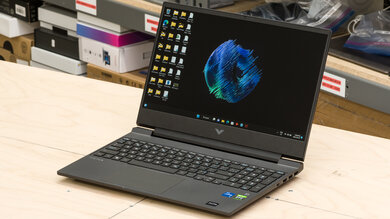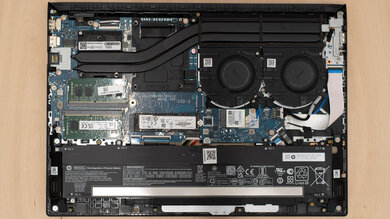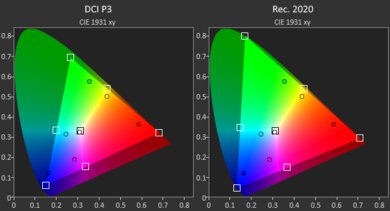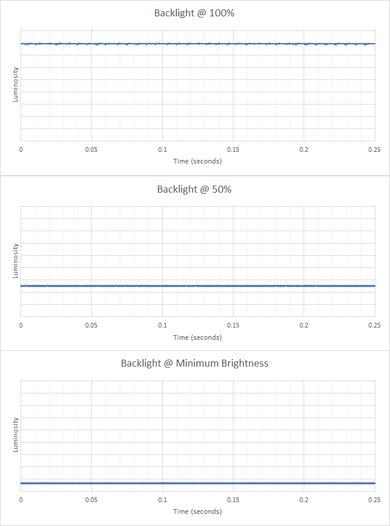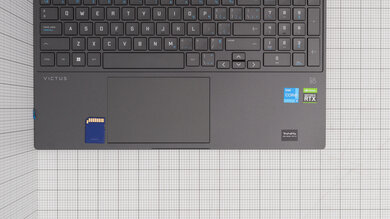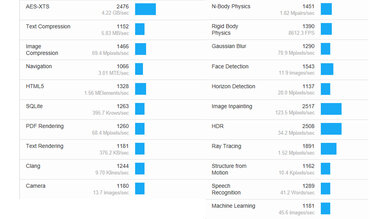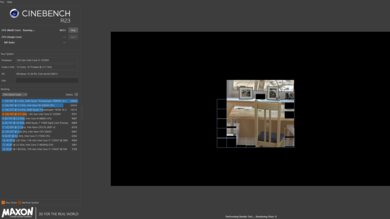The HP Victus 15 (2022) is a 15.6-inch budget gaming laptop. It's available with Intel 12th Gen. Core i5 or i7 CPUs and multiple NVIDIA discrete GPUs, from a GeForce GTX 1650 to an RTX 3050 Ti. There are also multiple 1080p display options with a refresh rate of 60Hz or 144Hz. Memory and storage max out at 16GB and 1TB, respectively. It has Wi-Fi 6 wireless connectivity, a 720p webcam, and a 70Wh battery. Its port selection includes two USB-As, one USB-C, an HDMI 2.1, an SD card reader, an Ethernet, and a 3.5mm headphone jack. Its USB-C port supports video output but not charging. You can see our unit's specifications and all the available configuration options in the Differences Between Variants section below.
Our Verdict
The HP Victus 15 is okay for school use. It feels well-built but isn't very portable, as it's a little bulky and heavy. The display provides plenty of space for split-screen multitasking, the keyboard feels spacious and tactile, and the touchpad is large and responsive. Its CPU and GPU can handle demanding tasks, making it suitable for students in more technical fields like 3D graphics. Unfortunately, the display doesn't get bright enough to combat glare, and its battery doesn't last a full day.
- Comfortable keyboard and responsive touchpad.
- CPU and discrete GPU can handle demanding workloads.
- Good port selection.
- Bulky and heavy.
- Short battery life.
- Webcam image looks soft and underexposed.
The HP Victus 15 is great for gaming. It's available with Intel 12th Gen. CPUs and NVIDIA discrete graphics, which are powerful enough to provide a smooth gaming experience in demanding AAA titles at 1080p. It has a nice keyboard and a fast SSD, as well as Wi-Fi 6 and Ethernet connectivity for low-latency online gaming. Unfortunately, its 144Hz display has a slow response time causing noticeable ghosting, and it doesn't support variable refresh rate to reduce screen tearing.
- Delivers smooth gameplay at 1080p.
- Fast SSD.
- User-replaceable memory and storage.
- Good port selection.
- No VRR to reduce screen tearing.
- Some performance loss on CPU under load.
The HP Victus 15 is mediocre for media consumption. It isn't very portable because it's bulky and heavy; however, you get pretty decent battery life, as it lasts five to six hours of video playback, giving you plenty of time to get through a couple of full-length movies. Unfortunately, all the available displays look washed out except for the top-end 144Hz panel with full sRGB coverage. Also, none of the displays are well suited for dark room viewing, as they all have a low contrast ratio. The speakers sound clear and get reasonably loud, but they don't have much bass and treble, so they aren't the best for music listening.
- Decent battery life for video playback.
- Speakers get reasonably loud and sound clear.
- Display coating handles reflections well.
- Bulky and heavy.
- Display looks washed out unless you get the top-end screen option.
- Speakers have no bass.
The HP Victus 15 is excellent for use as a workstation. Its Intel 12th Gen. CPUs and NVIDIA discrete GPUs can handle demanding tasks like video editing and 3D rendering. It loses some performance under load but doesn't get hot or loud. While you can only get up to 16GB of memory and 1TB of storage, these components are user-replaceable, meaning you can add more later on. The main downsides are that none of the display options support a wide color gamut for color work like photo and video editing, and its USB-C doesn't support Thunderbolt 4.
- Comfortable keyboard and responsive touchpad.
- CPU and discrete GPU can handle demanding workloads.
- Fast SSD.
- User-replaceable memory and storage.
- Good port selection.
- Some performance loss on CPU under load.
- No Thunderbolt 4.
The HP Victus 15 is good for business use. It has a large 15.6-inch display that's well-suited for multitasking, a spacious and tactile keyboard, and a large and responsive touchpad. Its Intel 12th Gen. CPU can handle most productivity tasks, like text processing, spreadsheets, and presentations. You can even do some video editing for your business, thanks to its discrete graphics. There are a few downsides, though. None of the displays get particularly bright, so you'll likely have visibility issues in well-lit rooms, and its battery doesn't last a full workday. Also, while it feels well-built, it isn't very portable because it's bulky and heavy.
- Comfortable keyboard and responsive touchpad.
- CPU and discrete GPU can handle demanding workloads.
- Good port selection.
- Bulky and heavy.
- Short battery life.
- Webcam image looks soft and underexposed.
Changelog
- Updated Oct 04, 2024: Added mention of the MSI Katana A15 AI (2024) as an alternative with a QHD display options in the Screen Specs section.
- Updated Feb 29, 2024: Added mention of the Lenovo LOQ 15 (2023) as an alternative available with NVIDIA 40-series GPUs in the GPU section.
- Updated Feb 14, 2024: Added mention of the ASUS TUF Gaming A16 Advantage Edition as an alternative with VRR support in the Refresh Rate section.
- Updated Dec 07, 2023: Converted to Test Bench 0.8.2.
Differences Between Sizes And Variants
We tested the HP Victus 15 (model 15-fa0088ca) with an FHD 144Hz display, an Intel Core i5-12500H CPU, an NVIDIA GeForce RTX 3050 Laptop GPU, 16GB of memory, and 512GB of storage. The display, CPU, GPU, memory, and storage are configurable; you can see the available options in the table below. Our review applies to all variants in the HP 15-fa0000 series.
| Screen |
|
|---|---|
| CPU |
|
| GPU |
|
| Memory |
|
| Storage |
|
| Color |
|
You can see our unit's label here.
Popular Laptop Comparisons
The HP Victus 15 is a very good budget gaming laptop. It stands out for its sturdy build and great thermal and noise handling; however, it doesn't have as many GPU options as other laptops in its class and lacks Thunderbolt 4 support.
For more options, check out our recommendations for the best gaming laptops, the best budget and cheap laptops, and the best laptops.
The Lenovo LOQ 15 (2023) is better than the HP Victus 15 (2022) for most uses. The Lenovo is available with newer and faster NVIDIA 40-series GPUs that can push higher frame rates. It also has variable refresh rate support to reduce screen tearing, two M.2 storage slots (the HP has one), and longer battery life. Lenovo has a QHD display option, while HP only has FHD displays.
The HP Victus 15 (2022) and the Lenovo IdeaPad Gaming 3 (2021) are very similar. The HP is available with faster Intel 12th Gen. CPUs; however, the Lenovo has a higher-end NVIDIA RTX GeForce 3060 GPU option, which outperforms all the GPUs available on the HP. The HP has a better port selection, as it includes a USB-C and an HDMI 2.1 port, which the Lenovo lacks. The HP doesn't get as hot or loud as the Lenovo under load, but its CPU throttles slightly more than the Lenovo.
The ASUS TUF Dash F15 (2022) is better than the HP Victus 15 (2022) for most uses. The ASUS has a sturdier build, longer battery life, and a better port selection. It's also available with better displays, like an FHD 300Hz and QHD 165Hz panel, as well as higher-end GPUs, like RTX 3060 and 3070. It has better performance over time than the HP, meaning its performance doesn't drop as much in demanding workloads, but it does get hotter and louder.
The HP OMEN 16 (2022) is better than the HP Victus 15 (2022). The OMEN is a higher-end device with better display and GPU configuration options, like a QHD 165Hz panel and NVIDIA GeForce RTX 3060, 3070, and 3070 Ti GPUs. The OMEN also has better speakers and a more responsive touchpad. Ports-wise, the OMEN has a wider selection, including a USB-C with Thunderbolt 4 support; however, its HDMI is limited to HDMI 2.0, whereas the Victus supports HDMI 2.1. The OMEN doesn't get as hot or loud as the Victus, but it does lose more performance under load.
Test Results

The HP Victus 15 has a relatively simple design for a gaming laptop. It does have some 'gamer' aesthetics, like the hinge design and the 'V' logo, but overall, it's low-key and won't stick out too much in a professional work environment. On the bottom, you can find the speakers near the front and air vents near the back. There are also air vents on the back of the device and above the keyboard. This laptop is available in three colorways: Mica Silver, Ceramic White, and Performance Blue.
The HP Victus 15's build quality is good. It's mostly plastic but feels relatively sturdy and hefty, with evenly distributed weight. There's almost no flex on the lid with the laptop closed, but there's some in the display and keyboard deck. The finish doesn't scratch or pick up fingerprints easily, and the feet feel strong and stick firmly to the bottom.
The serviceability is great. To access the internals for upgrades and repairs, you only need to remove seven Philips screws and pry open the bottom panel. Once inside, all the replaceable components are easily accessible.
You can see the service manual here.
The HP Victus 15 laptop is available with the following displays:
- 15.6" TN 1920 x 1080 60Hz (45% NTSC)
- 15.6" IPS 1920 x 1080 60Hz (45% NTSC)
- 15.6" IPS 1920 x 1080 144Hz (45% NTSC)
- 15.6" IPS 1920 x 1080 144Hz (100% sRGB)
All four displays look identical in sharpness, so choose based on the panel type, refresh rate, and color performance (color gamut) you want. 16:9 is a common aspect ratio for gaming laptops and is well-suited for media consumption. It's fine for productivity, although a taller 16:10 or 3:2 aspect ratio would have been preferable, as it allows you to see more information when reading a document or website. Between the two 60Hz panels, it's best to go with the IPS option, as IPS panels usually have better viewing angles and color reproduction than TN. Check out the MSI Katana A15 AI (2024) if you want a laptop available with a QHD display.
As mentioned in the screen specs section, you can get the HP Victus 15 with a 60Hz or 144Hz display. For the best gaming experience, it's best to get a 144Hz display, as it will provide better responsiveness and deliver a clearer image in fast-moving scenes. There's some ghosting, as the response time is a little slow for a 144Hz display, but it's not too bad. The 60Hz displays will perform worse, producing a blurrier image with longer blur trails behind moving objects. Unfortunately, none of the displays support variable refresh rate to reduce screen tearing. If you want a similar gaming laptop with VRR support, check out the ASUS TUF Gaming A16 Advantage Edition (2023).
The 144Hz IPS (45% NTSC) panel's contrast ratio is okay and within the typical range for most IPS panels. However, it's still relatively low compared to other display technologies like VA and OELD. This contrast level makes blacks look gray in dim settings. The other panels will perform similarly except for the TN panel, which will likely be slightly worse, as TN panels usually have a lower contrast ratio.
The 144Hz (45% NTSC) display doesn't get very bright, so it's best suited for a dark to moderately-lit room. However, it gets very dim at the lowest brightness setting, which is great for dark room viewing as it's easier on the eyes. The other panels have the same peak brightness except for the top-end 144Hz 100% sRGB display, which has an advertised brightness of 300 cd/m². It's unlikely that it actually hits 300 cd/m², but it's an improvement nonetheless.
The HP Victus 15 has good reflection handling. Its matte coating is very effective in diffusing and reducing the intensity of bright light sources. Reflections are only a problem when viewing dark-color content. You can still see some when viewing light-color content with the screen at maximum brightness, but they aren't distracting.
The HP Victus 15's black uniformity is mediocre. There's clouding in many places as well as some backlight bleed at the top corners. The other IPS panels are likely similar; however, the 60Hz TN panel is significantly worse due to the TN panel's poor vertical viewing angle. You can see an example of a TN panel's black uniformity in our review of the Acer Aspire 3 15 (2023).
The horizontal viewing angle is okay. The image dims fairly quickly as you move to the side. The picture quality is still good enough from the side to share text documents and other casual content; however, you have to be close or directly in front of the screen if you need perfect accuracy. The other panels likely have a similar viewing angle except for the TN panel, as TN panels typically have a narrower viewing angle.
The vertical viewing angle is mediocre. Like the horizontal viewing angle, the image dims and washes out when viewed from above and below. You have to look at the screen almost straight-on if you want the best accuracy, which can be hard when you don't have much space to tilt the screen to your liking, like on a bus or airplane. The TN panel has a significantly worse vertical viewing angle because TN panels suffer from chroma inversion when viewed from below.
The HP Victus 15 display's out-of-the-box accuracy is decent. Most colors look inaccurate due to the panel's narrow color gamut, but the white balance is outstanding. The color temperature is only marginally higher than the standard 6500K target, not enough to make a difference visually. The gamma doesn't follow the sRGB curve; dark scenes look too dark, while bright scenes look too bright.
The 144Hz (45% NTSC) display's color gamut is bad. It doesn't even have full coverage of the commonly-used sRGB color space, meaning most content will look slightly washed out. Its coverage of the wider Adobe RGB and DCI P3 color spaces is too low for practical purposes. The two 60Hz displays have the same color gamut. The top-end 144Hz (300 cd/m²) has full sRGB coverage and will provide the best visual experience color-wise.
The HP Victus 15 has a great keyboard. It has a spacious layout that's easy to get used to. The keycaps feel smooth and relatively high-quality for a budget laptop. The keys are stable, have a good amount of travel, and require very little force to actuate. They aren't the most tactile but aren't mushy, either. Overall, this feels great to type on and doesn't cause fatigue over an extended period. Typing noise is fairly low and isn't bothersome in quiet environments. The keyboard is backlit, but there's no brightness adjustment, so you can only turn it on or off.
The touchpad is great. It's large and feels smooth and high-quality even though it's plastic. It tracks all movements and gestures well, and there are no issues with palm rejection. There's no problem with actions like dragging and dropping or zooming in and out of images, either. The only downsides are that you can only click in the bottom half of the touchpad, and the feel of the click is just okay.
The HP Victus 15 has good speakers. They get reasonably loud with minimal compression artifacts at max volume. They sound clear and relatively natural but have very little bass and treble extension. They're good for speech-heavy content and video calls, not music and movies.
The webcam is just okay. The image is far too underexposed, and there's very little fine detail due to noise. The microphone is pretty good, though. Voices sound quiet but clear, with only a small amount of background noise.
The HP Victus 15 has a good port selection. Both USB-A ports support USB 3.2 Gen. 1 data transfer speed (up to 5Gbps); the only difference is that the left one supports HP Sleep and Charge, which allows you to charge a mobile device, even when the laptop is in sleep mode. The USB-C port also supports USB 3.2 Gen. 1 data transfer speed, as well as DisplayPort Alt Mode and HP Sleep and Charge. You can't charge the laptop via USB-C.
The wireless adapter is a MediaTek MT7921. You can also get the laptop with an Intel AX211 Wi-Fi 6E adapter.
The HP Victus 15 is available with the following CPUs:
- Intel Core i5-12450H (8 cores/12 threads (4P/4E), up to 4.4GHz, 12MB cache)
- Intel Core i5-12500H (12 cores/16 threads (4P/8E), up to 4.5GHz, 18MB cache)
- Intel Core i7-12650H (10 cores/16 threads (6P/4E), up to 4.5GHz, 24MB cache)
- Intel Core i7-12700H (14 cores/20 threads (6P/8E), up to 4.7GHz, 24MB cache)
All four CPUs are high-performance mobile processors typically found in gaming laptops and mobile workstations, and they all have a hybrid architecture with a mix of performance and efficiency cores. The main difference between the Core i5s and i7s is the number of performance cores; the i5s have four, while the i7s have six. As for the efficiency cores, the i5-12450H and i7-12650H have four, while the i5-12500H and i7-12700H have eight. Upgrading to a higher-tier CPU with more cores and threads will improve performance, especially in large, open-world games. However, the performance increase is much smaller and less noticeable in GPU-limited games where CPU utilization is typically low. That said, it might still be worth upgrading if you want to stream or often leave things running in the background while gaming.
The HP Victus 15 is available with the following GPUs:
- NVIDIA GeForce GTX 1650 Laptop 4GB GDDR6 (50W TGP)
- NVIDIA GeForce RTX 3050 Laptop 4GB GDDR6 (75W TGP)
- NVIDIA GeForce RTX 3050 Ti Laptop 4GB GDDR6 (75W TGP)
All three are entry-level discrete GPUs designed for 1080p gaming. The NVIDIA GeForce GTX 1650 is the slowest; it can push 60 fps in demanding games, but you'll almost always have to play with low settings. The RTX 3050 is faster and will allow you to play with slightly higher graphical settings. The RTX 3050 Ti is only about 10% faster than the 3050 Ti. The RTX 3050 and 3050 Ti have features that aren't present on the GTX 1650, like ray-tracing and DLSS. It generally isn't worth turning on ray-tracing on a 3050 or 3050 Ti due to the performance cost, so don't base your purchasing decision on that feature. These GPUs also support DLSS (Deep Learning Super Sampling), which improves performance (in supported games) by rendering the scene at a lower resolution and subsequently upscaling it through A.I. This feature can help provide smoother gameplay; however, its effectiveness varies from game to game, and it also has a lesser effect when gaming at 1080p. If you want a gaming laptop available with NVIDIA 40-series GPUs, which support Frame Generation, check out the Lenovo LOQ 15 (2023).
You can configure this laptop with 8GB, 12GB, or 16GB of memory. For gaming, it's best to get 16GB, as the lack of memory can cause stutter. The memory is user-upgradeable, though, so you can always add more later on. For the 8GB configuration, you can choose to have the memory in single- (1x 8GB) or dual-channel (2x 4GB) mode. Dual-channel provides better performance.
You can configure the HP Victus 15 with 256GB, 512GB, or 1TB of storage.
The HP Victus 15's overall score in Geekbench 5 is outstanding, as the Intel Core i5-12500H has exceptional single- and multi-thread performance. All four available CPUs can handle general productivity tasks like text processing and web browsing, as well as demanding workloads like video editing and 3D graphics. If you often perform intensive tasks or heavy multitasking, go with one of the Core i7s, as they have more performance cores and can process more threads simultaneously, allowing you to complete tasks faster with fewer slowdowns or stutters. For GPU computing tasks, the NVIDIA GeForce RTX 3050 also performs very well. That said, the RTX 3050 is still an entry-level GPU. If you're a professional working with complex material, you'll get a much smoother experience on a laptop with a higher-end GPU, like an RTX 3070, 3080, or 3080 Ti. As for the other GPU options on the Victus 15, the GTX 1650 is slower, while the RTX 3050 Ti is marginally faster.
The HP Victus 15's Intel Core i5-12500H performs exceptionally well in Cinebench R23. Every available CPU can handle rendering and other CPU-heavy workloads, so it's just a matter of how fast you want to get things done. If you're a professional working with strict deadlines, get a model with a Core i7, as the i7s have more performance cores and will complete tasks faster.
The HP Victus 15's 3D rendering performance in Blender is excellent. The Intel Core i5-12500H renders relatively quickly; however, there's no need to render with the CPU because the dedicated GPU can do it significantly faster, especially when using NVIDIA Optix hardware acceleration. The GTX 1650 will be slower, while the 3050 Ti will be marginally faster.
The NVIDIA GeForce RTX 3050 Laptop GPU in the HP Victus 15 scores well in the Basemark GPU benchmark. The RTX 3050 is a 1080p 60 fps gaming GPU. It can push over 60 fps in graphically demanding titles, but you'll have to play at medium or low settings. The RTX 3050 Ti is about 10% faster, which means it can push over 60 fps with fewer tweaks in the settings. The GTX 1650 is the slowest of the three; it can reach 60 fps, but you'll almost always have to play with the lowest graphical settings.
The HP Victus 15's PCIe Gen. 4 x4 NVMe SSD performs exceptionally well. Its fast read and write speeds allow the system to quickly boot up, launch apps, and copy files. The 1TB drive is likely faster, as larger SSDs typically perform better.
The HP Victus 15's battery life is sub-par. Even if you only perform light tasks, you'll have to plug it in for a quick charge to get through a typical 8-hour work or school day. The battery life for video playback is decent, though, giving you enough time for a couple of full-length movies. For gaming and other demanding workloads, the battery life is short but within the typical range for laptops with an H-series CPU and discrete graphics. Models with a 60Hz display will have longer battery life, while models with a Core i7 will likely have shorter battery life.
Note: Models with an NVIDIA GeForce GTX 1650 GPU have a 52.5Wh battery. The smaller battery capacity usually results in shorter battery life; however, the GTX 1650 draws less power than the RTX 3050 and 3050 Ti, so the battery life might end up being roughly the same as a model with a 70Wh battery.
Borderlands 3 runs poorly on the HP Victus 15 at 1080p with high settings. The gameplay is very choppy due to frequent frame drops. However, it's much smoother with medium to low settings. You'll likely have to play with the lowest graphical settings to reach a stable 60 fps on models with a GTX 1650. The RTX 3050 Ti will only perform slightly better than the 3050.
Civilization VI runs well. This game isn't particularly GPU-intensive, so every GPU can push high frame rates and provide smooth gameplay. The turn time is okay with an Intel Core i5-12500H; it's a little slower than expected, as most Intel 12th Gen. CPUs can push faster turn times. Upgrading to the Core i7-12650H or i7-12700H will improve the turn time, bringing it closer to seven seconds.
The performance in CS:GO is outstanding. The gameplay is very smooth at 1080p with high settings. There are stutters, but they happen very rarely. Every configuration can provide smooth gameplay in this and other similar games.
Shadow of the Tomb Raider runs decently well. The Intel Core i5-12500H and NVIDIA GeForce RTX 3050 can push over 60 fps at 1080p with high settings. There are noticeable stutters, but they don't happen all that often. It's best to run this game at medium or low settings for the smoothest experience. Every configuration can run this game and other similarly-demanding titles smoothly; you just have to tweak the settings a bit.
The HP Victus 15 has great thermal and noise handling. The keyboard is cool when idle, and the fans are near-silent. The keyboard gets much hotter under load; however, the heat is mostly on the right side of the keyboard around the backspace key, away from where most people rest their hands. The fans produce a slightly whistle-like noise, but it isn't loud. The posted numbers were taken in the Default power profile. You can change the power profile to Quiet or Performance in the OMEN Gaming hub application.
The HP Victus 15's performance over time is great. Neither the CPU nor the GPU gets particularly hot under load. There's some throttling on the CPU; the performance loss isn't significant but still noticeable. In contrast, the performance loss on the GPU isn't noticeable at all. Switching to the Performance profile has minimal effect on the amount of performance loss; however, it raises the temperatures a few degrees, pushing the CPU to 72°C and the GPU to 68°C.
The HP Victus 15 has many pre-installed applications, including:
- Alexa: Amazon's digital assistant.
- Clipchamp video editor: Video editing software.
- Dropbox promotion: Ads for Dropbox file hosting service.
- Express VPN: Virtual private network service. Requires subscription to use.
- LastPass: Password manager.
- McAfee LiveSafe: Antivirus and internet security software.
- myHP: Online store for HP products.
- HP Documentation: Contains user guide and warranty information, as well as regulatory, safety, and environmental notices.
- HP PC Hardware Diagnostics Windows: Diagnostic tools to find and fix PC issues.
- HP Privacy Settings: Lets you choose the type of information you share with HP.
- HP Quickdrop: Lets you transfer files wirelessly between your PC and mobile devices.
- HP Smart: Companion app for HP printers.
- HP Support Assistant: Helps with system updates and troubleshooting of common issues. Connects you to an HP Virtual Agent for further troubleshooting.
- HP System Event Utility: Lets you program special function keys or shortcuts, like turning the wireless on or off and adjusting the screen brightness.
- OMEN Gaming Hub: Lets you access your installed games, HP rewards, and picture gallery. It also lets you see system information like CPU and GPU usage and temperatures, optimize the PC, and change the power profile.
- Solitaire Collection: Free online Solitaire Collection games.
- Solitaire: Solitaire card game.
- WildTangent Games: Collection of casual games from WildTangent.

